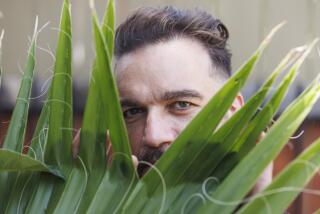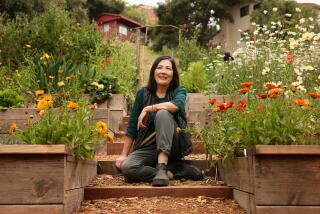On the cutting hedge
- Share via
ELFIN FOREST — The road to Charles and Jennifer Coburn’s home meanders through the hills north and east of San Diego. Their property is a quick left off the main road and up a winding drive that ends in a field filled with animals. An older gent stands on a ladder to groom a handsome stallion. His clippers make a snap, snap, snapping sound as he trims bright green privet leaves along the stallion’s spine. Giant steel bird skeletons flank the horse, waiting to be planted with gray-leaved olive trees and red-berried Pyracantha bushes.
The Coburns practice topiary, an art that goes back to ancient Roman gardeners who clipped and shaped shrubs into animal forms and geometric shapes. Today, most topiaries are tabletop-sized chicken wire forms filled with sphagnum moss and planted in ivy. But the owners of Coburn Topiary & Garden Art have taken the garden art in a different direction. They design huge, sculptural metal frames and plant them with full-sized trees and shrubs. Their pieces decorate estates, resorts, commercial properties and public spaces such as Disneyland and Legoland, and cities including Beverly Hills, Las Vegas and Nagoya, Japan.
In Westwind Park at Playa Vista, for example, stands a pair of giant topiary warblers. Paul Haden, president and founder of the Collaborative West landscape architecture firm of San Clemente, asked the Coburns to create topiary that would make the small, pocket park adjacent to Ballona Wetlands feel playful and fanciful. The result? “The Coburns’ style and ability gave wings to our ideas,” Haden says. “I have gotten untold calls from people telling us that the topiary birds put a smile on their faces.”
Jennifer emerges from the giant, barn-like studio and greets her stepfather, on the ladder, as she leads a visitor inside. The space is filled with steel frames in various stages of construction. Some are larger-than-life animals -- 6-foot-tall dogs and cats for a pet supply store; two giant swans for a Beverly Hills residence; and enormous geometrics including two “pyramisques,” combination pyramid-obelisks made for the streetscape along Rodeo Drive south of Wilshire Boulevard.
Jennifer Coburn has been making topiary since the 1980s. She started with ivy and sphagnum moss. Then, working with her sister who is a horticulturist, Jennifer started experimenting with woody trees and shrubs. It wasn’t until Jennifer married Charles, however, that the horticulture component of her art fully bloomed.
The couple met in 1991, when Charles was the head of horticulture at the San Diego Zoo. For the zoo’s 75th anniversary, he organized a conference of topiary artists, which Jennifer attended. The two connected and, three months later, were married.
“It was the perfect union,” Jennifer says. “He was at the zoo working with plants and animals, and I was making animals out of plants.”
For a time, they maintained their individual professions, with Jennifer building a stable of residential and commercial clients. Then, Legoland commissioned a small herd of life-sized topiary buffalo, several sheep, an 18-foot-tall Jack and the Beanstalk and assorted geometric shapes.
It was such a big job that Charles took early retirement from the zoo to work with her full time. Right away, he took charge of plants -- selection and acquisition, planting and ongoing care.
In a way, Charles was returning to his roots in joining the topiary business. As a younger man, he did ironwork and blacksmithing but found it challenging to make a living. So, he went into horticulture. All those years, however, he longed both to create art and to bring artists into gardens. Then he met his future wife. “Jennifer was the incarnation of art,” Charles says, “and here was my opportunity to do what I’d been talking about. It has been a learning process ever since.”
Part of that learning has to do with exploring new ideas, new tools and new technologies. Their topiary components were once cut by hand, but now they are formed with a computer-controlled plasma cutter. The plasma cutter slices quarter-inch thick sheets of steel plate into parts that the Coburns hand-weld into topiary frames.
Each topiary starts out as one of Jennifer’s sketches, which she scans into the computer. Using AutoCAD, she transforms a sketch into multilayered schematics. For each cutting plan, she has to specify a number of variables, including where to make the first cut and how to lay parts out to make the most efficient use of materials.
The plasma cutter does its work on flat steel, but topiaries are three-dimensional, with curvature and substance. How do the Coburns do that? With careful planning Jennifer explains: “I see all three dimensions in my mind as I generate the design,” she says. “That is where I have an advantage over other topiary artists.”
Jennifer demonstrates the massive plasma cutter at work. She starts up the on-board computer and searches through files of forms -- globes, alligator, cowboy, Pegasus and Dumbo, to name a few.
With a sheet of steel ready on the table, Jennifer turns on the machinery. “I feel like the scientist in Frankenstein’s laboratory,” she says as she moves about the room, pushing buttons, flipping circuit breakers and switches. She starts with a massive fuse box, then turns on the plasma cutter’s cooler (plasma cutting uses an arc of electricity that gets so hot it can slice through steel) and a small fan that keeps Jennifer cool. The phase generator goes on next, then an air compressor, an exhaust fan and a variety of other components. Finally, Jennifer opens the valve on a giant canister of oxygen and hits the “on” switch for the plasma cutter.
By now, the machinery’s hum is much too loud for conversation. So, without comment, Jennifer hands her visitor dark safety glasses.
Then, the magic begins. The robotic arm of the plasma cutter moves gracefully up and back over a sheet of smooth gray steel. Bolts of channelized lightening shoot through the metal as they slice out Jennifer’s design. In just a few moments the cutting is complete, and the plasma cutter’s arm returns to home position. Jennifer goes around the room in reverse order, shutting down the equipment. The sudden silence is a shock.
“Done!” Jennifer says in her singsong voice as she reaches for what looks like an enormous plunger that she flings down onto the cutout form. In reality, the plunger is a huge magnet used for lifting the shape (which happens to be a foot-tall seated elf playing a flute). “I use the magnet because the metal is too hot to handle,” she explains.
Charles welds the elf to its base -- a 10-inch-long leaf Jennifer curled slightly by running it through what looks like an old-fashioned wringer-washer. Together, the two pieces make a whimsical, seated elf to perch on a ledge or a shelf. It isn’t topiary per se, but it is part of their product line, much like the metalwork that decorates the rock-faced street monuments they made for their small, tightknit community. Each features the street name along with animal figures -- soaring hawks and toddling quails -- all cut from steel.
Jennifer talks about the opportunities that technology brings to their business.
“The new evolution,” she says, “is that in addition to creating plants as topiary and living sculpture, I want to make metal sculptures of topiary.” She points to puzzle-like pieces shaped like ivy leaves. Soon, she will weld them together to form a large dog. There won’t be a frame, just the metal leaf cutouts welded into a mesh-like skin. Jennifer plans to wind ivy vines in and out of the metal leaves as an accent.
Why focus on frames and give plants a lesser role? To make it easier for clients, Charles explains. “People want topiaries, but not everyone can maintain a topiary.”
The quality of their metalwork and the metal finishes also distinguish the Coburn’s topiaries. All of their frames are carefully coated with layers of colored glazes to create lush iridescence. Glazes are applied only after the metal is sandblasted, epoxied and zinc-coated to make it weatherproof. Recently, Jennifer added a kiln to her tool arsenal. The kiln will allow her to embellish metal frames with bits of fused and slab glass.
While Jennifer generates new ideas and designs, Charles provides technical skill and spiritual inspiration.
“Charles reminds me that we are the instrument and that our art comes through us,” Jennifer says. Knowing that, she continues, allows them to set ego aside and “let the muses play.”
As Charles explains, “I want people to identify with our art because it is a natural expression of who we are. As human beings, our individual roles are all somewhat different, but we share a lot of common ground. That is the joy of being human, that richness of human experience, so we feel real community and commonality.”
--
More to Read
Sign up for The Wild
We’ll help you find the best places to hike, bike and run, as well as the perfect silent spots for meditation and yoga.
You may occasionally receive promotional content from the Los Angeles Times.






